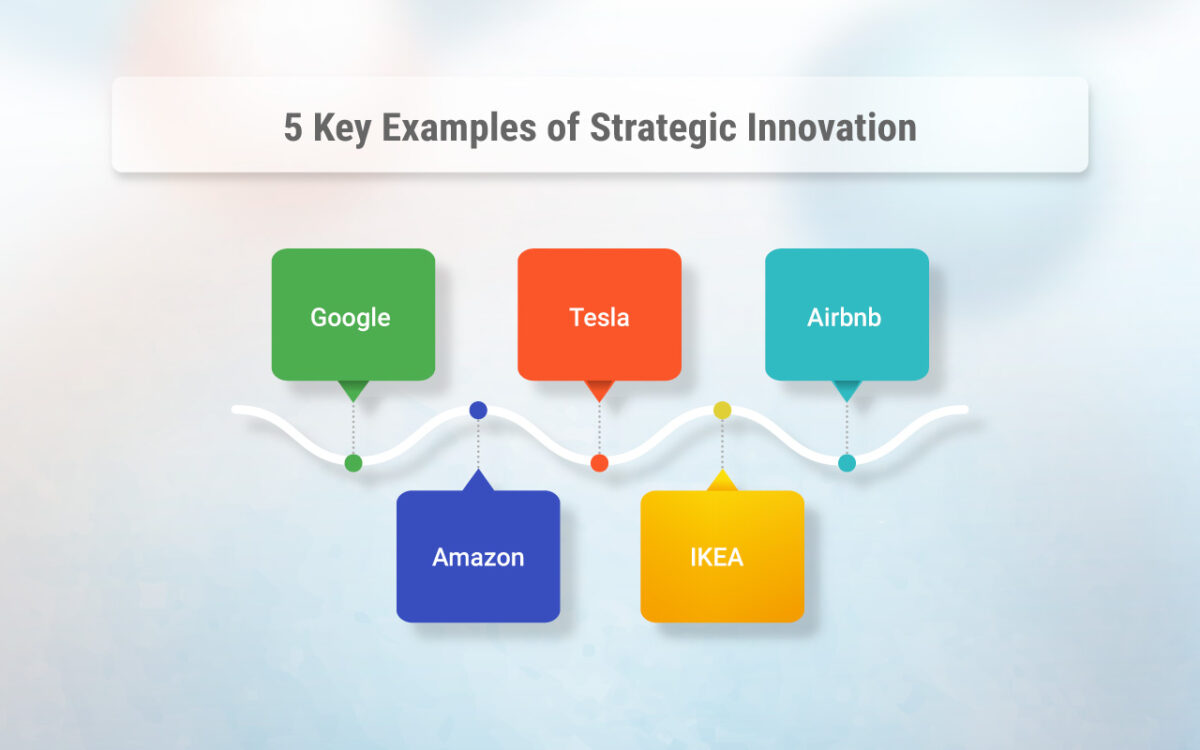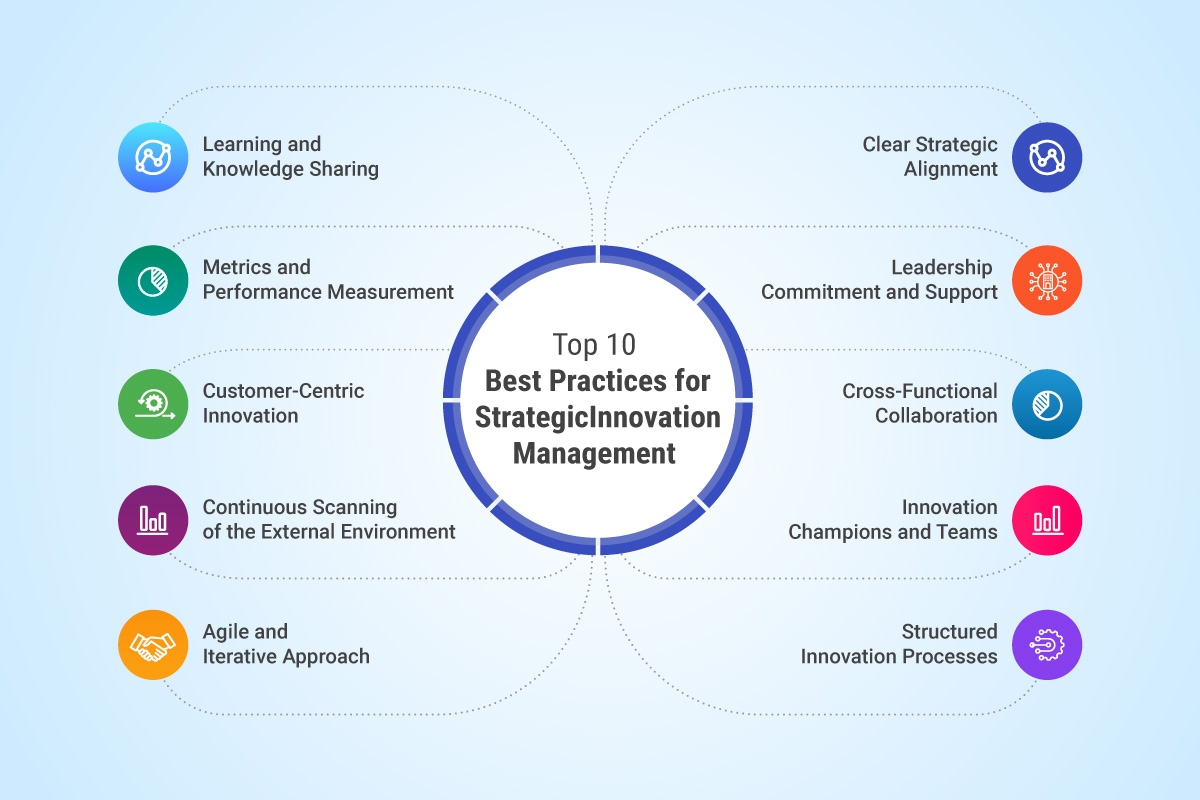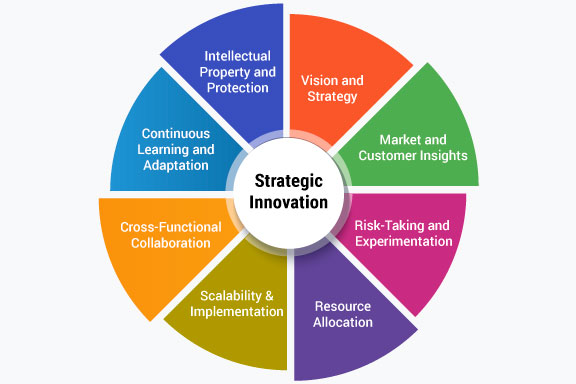What is Strategic Innovation?
Strategic innovation is defined as the deliberate and systematic approach of developing and implementing new ideas, products, services, or processes that drive significant organizational growth, competitive advantage, and long-term success. It involves aligning innovation efforts with the overall strategic goals and vision of an organization.
Strategic innovation goes beyond incremental innovation improvements and focuses on transformative and disruptive innovation initiatives that can shape the future of the organization and its industry. Here are the key Components to Drive Strategic Innovation:
- Vision and Strategy: Strategic innovation starts with a clear vision and strategic direction. It requires a deep understanding of the organization’s goals, market dynamics, customer needs, and competitive landscape. The innovation strategy should be aligned with the overall strategic objectives of the organization and provide a roadmap for achieving them.
- Market and Customer Insights: Successful strategic innovation requires a thorough understanding of market trends, emerging technologies, and customer needs and preferences. Gathering market intelligence and conducting customer research helps identify opportunities for innovation and ensures that new initiatives are customer-centric.
- Risk-Taking and Experimentation: Strategic innovation involves taking calculated risks and embracing experimentation. It requires a willingness to challenge existing norms, try new approaches, and learn from failures. Organizations that foster a culture of innovation encourage employees to take calculated risks and provide the necessary support and resources for experimentation.
- Cross-Functional Collaboration: Strategic innovation often requires collaboration across different functions and departments within an organization. Breaking down silos and fostering cross-functional collaboration allows for diverse perspectives, expertise, and knowledge to come together and drive ideation and solutions.
- Resource Allocation: Strategic innovation requires proper resource allocation. It involves allocating financial, human, and technological resources to support innovative initiatives. Organizations need to prioritize and invest in strategic innovation projects to ensure they receive the necessary resources and support for success.
- Scalability and Implementation: Strategic innovation focuses on initiatives that have the potential for scalability and broad impact. It involves developing implementation plans, setting milestones, and ensuring proper execution to bring innovative ideas to market successfully.
- Continuous Learning and Adaptation: Strategic innovation is an iterative process that requires continuous learning and adaptation. It involves gathering feedback, measuring results, and using insights to refine and improve innovation efforts over time. Organizations that embrace a learning mindset can adapt to changing market conditions and stay ahead with continuous innovation.
- Intellectual Property and Protection: Strategic innovation often involves the development of intellectual property (IP) such as patents, trademarks, or copyrights. Protecting IP rights is crucial to secure a competitive advantage and prevent the unauthorized use or replication of innovative ideas and solutions.
By incorporating these key components, organizations can effectively drive strategic innovation, seize new opportunities, and navigate the evolving business landscape with a forward-thinking and competitive approach.
Learn more: What is Disruptive Innovation?
5 Key Examples of Strategic Innovation

Here are a few examples of brands where strategic innovation led to their success:
- Google: Google’s strategic innovation is evident in its search engine technology and its continuous innovation of products and services. Google’s search algorithm revolutionized online search, providing highly relevant and accurate results. Google’s expansion into various areas such as online advertising (Google Ads), email services (Gmail), mobile operating systems (Android), and cloud computing (Google Cloud) showcases its commitment to strategic innovation.
- Tesla: Tesla’s strategic innovation lies in its development and commercialization of electric vehicles (EVs) that offer long-range capabilities, superior performance, and cutting-edge technology. By focusing on sustainable and disruptive innovation in the traditional automotive industry, Tesla has transformed the perception of EVs and has become a leader in the electric vehicle market.
- Airbnb: Airbnb’s strategic innovation disrupted the hospitality industry by providing a platform that enables individuals to rent out their homes or spare rooms to travelers. By leveraging the sharing economy model, Airbnb created a new market and challenged traditional hotel chains. Its business model innovation has revolutionized the way people travel and disrupted the traditional accommodation sector.
- Amazon: Amazon’s strategic innovation is centered around its e-commerce platform and its continuous efforts to enhance customer experience and delivery efficiency. Amazon pioneered one-click purchasing, and same-day delivery, and introduced innovations such as Amazon Prime and its voice-activated assistant, Alexa. Through strategic acquisitions and investments, Amazon has expanded its offerings beyond e-commerce, including cloud computing services (Amazon Web Services) and smart home devices (Amazon Echo).
- IKEA: IKEA’s strategic innovation is focused on providing affordable and well-designed furniture and home products. By adopting a flat-pack, self-assembly model, IKEA revolutionized the furniture industry and created a unique shopping experience through its vast showroom-style stores. IKEA’s sustainable innovation initiatives, such as offering energy-efficient products and promoting recycling, further contribute to its strategic innovation efforts.
These examples highlight how organizations have strategically innovated to disrupt industries, introduce new business models, improve customer experiences, and address sustainability challenges. Strategic innovation can transform industries, create new markets, and position organizations for long-term success.
Learn more: What is Innovation Management?
Strategic Innovation Process: 10 Key Steps
A strategic innovation process is a systematic approach to identifying, developing, and implementing innovative ideas that align with an organization’s strategic objectives. While the specific steps may vary depending on the organization and context, the following components generally form the strategic innovation process:
1. Define Strategic Direction
Start by clearly defining the organization’s strategic direction and goals. Understand the industry landscape, market trends, and competitive dynamics. Identify areas where innovation can contribute to achieving strategic objectives.
2. Identify Opportunities
Conduct market research, gather customer insights, and analyze emerging trends to identify potential areas for innovation. Explore unmet customer needs, technological advancements, and market gaps that present opportunities for disruptive innovation.
3. Idea Generation
Encourage ideation and creativity across the organization. Utilize techniques such as brainstorming sessions, hackathons, design thinking workshops, and open innovation platforms to generate a diverse range of ideas. Encourage input from employees, customers, and external stakeholders.
4. Idea Evaluation and Selection
Evaluate and prioritize the generated ideas based on their alignment with strategic goals, feasibility, potential impact, and market viability. Assess the technical, financial, and operational feasibility of each idea. Use criteria such as market potential, competitive advantage, and resource requirements to select ideas for further development.
5. Concept Development and Prototyping
Develop detailed concepts and create prototypes or minimum viable products (MVPs) for selected ideas. Refine the concepts through iterative customer research and testing. This stage may involve cross-functional collaboration, design iterations, feasibility studies, and validation with stakeholders.
6. Business Case Development
Conduct a thorough analysis through market research, customer experience (CX) research, competition, financial implications, and risks associated with the selected innovation concepts. Develop a business case that outlines the value proposition, market potential, implementation plan, resource requirements, and expected return on investment.
7. Resource Allocation
Secure the necessary resources, including financial, human, and technological, to support the implementation of the selected innovation initiatives. Align resource allocation with the strategic importance and potential impact of the initiatives. Prioritize resource allocation based on the organization’s capabilities and constraints.
8. Implementation and Execution
Develop a detailed implementation plan and execute the innovation initiatives. This may involve project management, cross-functional collaboration, monitoring progress, and making adjustments as needed. Clearly communicate the goals, objectives, and benefits of the initiatives to engage stakeholders and gain their support.
9. Performance Measurement and Evaluation
Define metrics and key performance indicators (KPIs) to monitor and measure the performance and impact of the implemented innovations. Regularly evaluate progress against the set goals and KPIs. Use customer feedback and insights to refine and improve the initiatives.
10. Learning and Continuous Improvement
Foster a culture of learning and continuous improvement. Encourage feedback, knowledge sharing, and lessons learned from the strategic innovation process. Capture insights to enhance future innovation efforts and adapt to evolving market conditions.
By following a systematic and structured strategic innovation process, organizations can increase their chances of successfully implementing innovative ideas that drive strategic growth, competitive advantage, and long-term success.
Learn more: What is a Culture of Innovation?
Top 10 Best Practices for Strategic Innovation Management

Implementing effective strategic innovation management practices can help organizations foster a culture of innovation, drive successful innovation initiatives, and achieve strategic objectives. Here are some best practices for strategic innovation management:
- Clear Strategic Alignment: Ensure that innovation efforts are aligned with the organization’s overall strategic direction and goals. Establish a clear link between innovation initiatives and the desired outcomes, such as growth, competitive advantage, or market expansion.
- Leadership Commitment and Support: Leadership plays a critical role in driving strategic innovation. Foster a supportive and innovative culture from top-level management. Encourage leaders to champion innovation, provide necessary resources, and actively participate in innovation initiatives.
- Cross-Functional Collaboration: Promote cross-functional collaboration and diverse perspectives within the organization. Break down silos and create opportunities for collaboration and idea-sharing among different teams, departments, and disciplines. Encourage open communication and create platforms for cross-pollination of ideas.
- Innovation Champions and Teams: Appoint innovation champions or create dedicated innovation teams responsible for driving and managing innovation initiatives. These individuals or teams should have the necessary skills, resources, and authority to lead and support innovation efforts within the organization.
- Structured Innovation Processes: Establish structured processes for innovation, from ideation to implementation. Develop guidelines, frameworks, and tools to facilitate idea generation, evaluation, selection, and implementation. Clearly define roles, responsibilities, and milestones at each stage of the innovation process.
- Agile and Iterative Approach: Embrace an agile and iterative approach to innovation. Encourage quick experimentation, learning from failures, and rapid iterations to refine ideas and improve outcomes. Adopt methodologies such as design thinking, lean startup, or agile project management to drive innovation in a flexible and adaptive manner.
- Continuous Scanning of the External Environment: Regularly scan and monitor the external environment, including industry trends, market disruptions, emerging technologies, and customer needs. Stay updated on changes in customer preferences, competitive landscape, and regulatory developments that may impact innovation strategies.
- Customer-Centric Innovation: Place a strong emphasis on understanding customer needs and preferences. Involve customers in the innovation process through feedback, co-creation, and user testing. Apply user-centered design principles to ensure that innovations meet the actual needs and expectations of customers.
- Metrics and Performance Measurement: Establish key performance indicators (KPIs) and metrics to measure the success and impact of innovation initiatives. Track and evaluate progress against these metrics regularly. Use the insights gained from performance measurement to refine strategies and improve innovation outcomes.
- Learning and Knowledge Sharing: Foster a learning culture within the organization. Encourage employees to share knowledge, best practices, and lessons learned from innovation initiatives. Create mechanisms, such as innovation showcases, internal communication channels, and innovation forums, to facilitate knowledge sharing and learning from past experiences.
By adopting these best practices, organizations can effectively manage strategic innovation, drive successful initiatives, and build a sustainable culture of innovation that supports long-term growth and competitiveness.
Learn more: What is Continuous Innovation?
Most Recent Blogs
Explore the latest innovation insights and trends with our recent blog posts.










